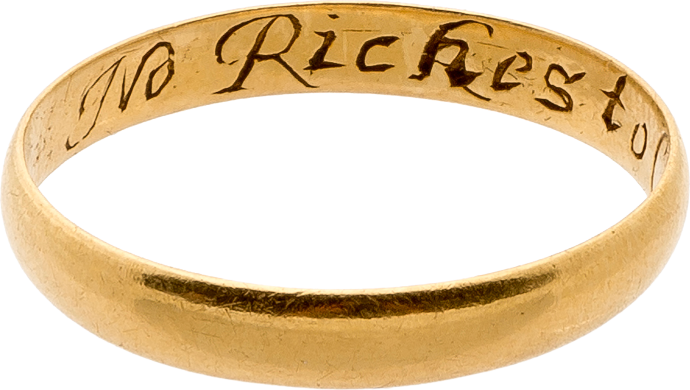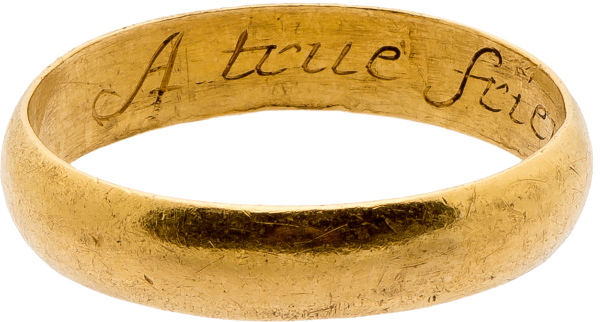Posy Ring No Riches to Content



Posy Ring “No riches to content”
, 18th century


Posy Ring “No riches to content”
Description
Rings with love mottos and inscriptions known as "posy rings," a term derived from the term poetry or poésie. They feature in the plays of William Shakespeare, such as in Hamlet (III, 2, 162) "Is this a prologue, or the posy of a ring" and in The Merchant of Venice. In 1579 John Lyly writes in his book Euphues and England : ".... Posies in your rings, which are always next to the finger, not to be seene of him that holdeth you by the hand, and yet knowne by you that weare them on your hands." Here Lyly describes a characteristic of the later posy rings, which have their message discretely concealed within the hoop, not to be seen other than by the giver and recipient. Posy rings enjoyed great popularity during the seventeenth and eighteenth centuries and were exchanged between friends, relatives, and lovers, and at betrothals and wedding ceremonies.
Description:
Gold band with D-section, plain on the exterior and on the interior are probably the initials of the giver "DMI" in capital letters and dotted lines (or a cryptic message in abbreviation), and the engraved inscription in italics "No riches to content." The ring is in good wearable condition.
The maker's mark in a crowned rectangular punch has the initials "DC" in capital letters may tentatively be identified with the London based goldsmiths Daniel Charter (registered in 1740), see: Arthur G. Grimwade, London Goldsmiths 1697-1837. Their Marks and their Lives from the Original Registers at Goldsmiths' Hall & other sources, 3rd ed., London 1990 (first published in 1976), p. 44) or Daniel Chapman (registered in 1729), see: Jackson's Silver & Gold Marks of England, Scotland & Ireland (ed. Ian Pickford), 3rd revised edition, Woodbridge Suffolk 2011 (first published 1905), p. 186.
Literature:
Joan Evans records several variations of this motto (Evans 1931, p. 84) among them a ring in the British Museum (Dalton 1912, no. 1272) and one in her own collection. For a history of posy rings with extensive list of posies, see Evans, 1931 and Anon., A Garland of Love: A Collection of Posy-Ring Mottoes, London 1907. For further information, see Dalton 1912, pp. 174 ff.; Scarisbrick 2007, pp. 74 ff., Taylor and Scarisbrick 1978, and Oman 1974, pp. 39 ff.
